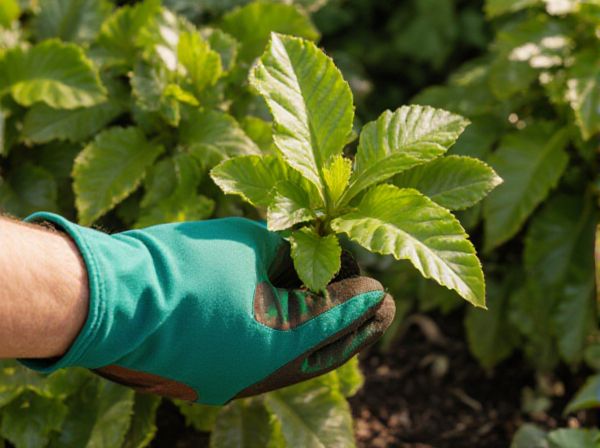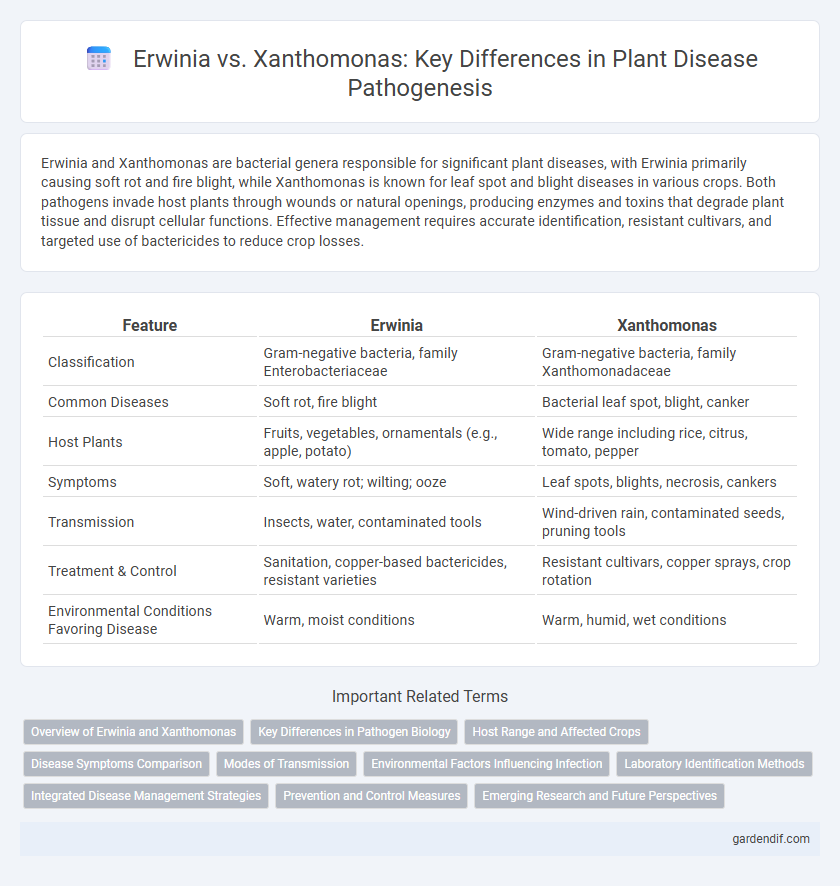
Erwinia vs Xanthomonas Illustration
Erwinia and Xanthomonas are bacterial genera responsible for significant plant diseases, with Erwinia primarily causing soft rot and fire blight, while Xanthomonas is known for leaf spot and blight diseases in various crops. Both pathogens invade host plants through wounds or natural openings, producing enzymes and toxins that degrade plant tissue and disrupt cellular functions. Effective management requires accurate identification, resistant cultivars, and targeted use of bactericides to reduce crop losses.
Table of Comparison
| Feature | Erwinia | Xanthomonas |
|---|---|---|
| Classification | Gram-negative bacteria, family Enterobacteriaceae | Gram-negative bacteria, family Xanthomonadaceae |
| Common Diseases | Soft rot, fire blight | Bacterial leaf spot, blight, canker |
| Host Plants | Fruits, vegetables, ornamentals (e.g., apple, potato) | Wide range including rice, citrus, tomato, pepper |
| Symptoms | Soft, watery rot; wilting; ooze | Leaf spots, blights, necrosis, cankers |
| Transmission | Insects, water, contaminated tools | Wind-driven rain, contaminated seeds, pruning tools |
| Treatment & Control | Sanitation, copper-based bactericides, resistant varieties | Resistant cultivars, copper sprays, crop rotation |
| Environmental Conditions Favoring Disease | Warm, moist conditions | Warm, humid, wet conditions |
Overview of Erwinia and Xanthomonas
Erwinia and Xanthomonas are bacterial genera that cause significant plant diseases, with Erwinia primarily responsible for soft rot and fire blight in fruits and vegetables, while Xanthomonas triggers various leaf spots, blights, and cankers across a wide range of host plants. Erwinia species such as Erwinia amylovora infect rosaceous plants, particularly apple and pear trees, resulting in economic losses due to fruit decay and shoot blight. Xanthomonas species exhibit high host specificity, with Xanthomonas campestris affecting crucifers and causing black rot, characterized by V-shaped chlorotic lesions on leaves.
Key Differences in Pathogen Biology
Erwinia species are Gram-negative bacteria primarily causing soft rot and wilt diseases by producing pectolytic enzymes that degrade plant cell walls, leading to tissue maceration. In contrast, Xanthomonas bacteria are also Gram-negative but cause a broader range of symptoms, including leaf spots and blights, through the delivery of type III secretion system effectors that manipulate host cellular processes. The fundamental distinction lies in their pathogenic strategies: Erwinia relies on enzymatic destruction of plant tissues, whereas Xanthomonas employs molecular effectors to disrupt host defenses and promote infection.
Host Range and Affected Crops
Erwinia primarily affects a wide range of fruit crops, including apples, pears, and stone fruits, causing diseases like fire blight and soft rot, while Xanthomonas targets various vegetable and field crops such as rice, citrus, and tomatoes, responsible for bacterial blight and leaf spot. The host range of Erwinia is mostly limited to woody plants and some herbaceous hosts, whereas Xanthomonas exhibits a broader host spectrum, infecting both monocots and dicots. Crop susceptibility varies with species and strain, influencing disease management strategies in agriculture and horticulture.
Disease Symptoms Comparison
Erwinia infections typically cause soft rot symptoms characterized by water-soaked, mushy tissue and foul odor, often leading to plant wilting and dieback. Xanthomonas diseases manifest as leaf spots, blights, or cankers with yellow halos and necrotic lesions, frequently resulting in chlorosis and defoliation. Both pathogens severely impact crop yield but differ in symptom expression; Erwinia targets tissue decay, while Xanthomonas primarily causes vascular and foliar damage.
Modes of Transmission
Erwinia primarily spreads through water, rain splash, and insect vectors such as aphids, facilitating entry via natural plant wounds or pruning cuts. Xanthomonas transmits mainly through contaminated seeds, wind-driven rain, and insect activity, entering plants through stomata or wounds. Both bacteria rely heavily on environmental conditions like humidity and temperature to enhance their dissemination and infection rates.
Environmental Factors Influencing Infection
Erwinia bacteria thrive in warm, moist environments that favor tissue maceration and facilitate rapid bacterial spread, especially under high humidity and water-saturated conditions. Xanthomonas species prefer moderate temperatures combined with prolonged leaf wetness, which promotes epiphytic survival and effective stomatal entry for infection. Both pathogens exhibit increased virulence when environmental stress weakens host plant defenses, emphasizing the critical role of microclimate and weather patterns in disease outbreaks.
Laboratory Identification Methods
Erwinia species are commonly identified in the laboratory using biochemical tests such as oxidase negativity, fermentation of glucose, and levan production, alongside molecular techniques like PCR targeting specific pectinolytic genes. Xanthomonas identification relies on detection methods including the use of selective media like Xanthomonas agar, hypersensitive response assays on tobacco leaves, and PCR assays targeting the hrp gene cluster essential for pathogenicity. Both genera benefit from advanced genomic sequencing and MALDI-TOF mass spectrometry for accurate species-level differentiation.
Integrated Disease Management Strategies
Integrated Disease Management (IDM) strategies for Erwinia and Xanthomonas focus on combining cultural practices, resistant cultivars, and precise chemical applications to reduce bacterial proliferation and crop damage. Crop rotation, proper sanitation of tools, and the removal of infected plant debris minimize inoculum sources for both pathogens. Monitoring environmental conditions and utilizing biocontrol agents further enhance disease control and promote sustainable agricultural production.
Prevention and Control Measures
Effective prevention and control measures for Erwinia and Xanthomonas primarily involve the use of certified disease-free seeds, crop rotation, and proper sanitation to eliminate infected plant debris. Chemical treatments such as copper-based bactericides and antibiotic sprays are commonly applied to manage bacterial populations, with integrated pest management (IPM) enhancing overall effectiveness. Resistant cultivars also play a crucial role in reducing susceptibility and limiting the spread of these phytopathogens in agricultural systems.
Emerging Research and Future Perspectives
Emerging research on Erwinia and Xanthomonas highlights advances in genomic sequencing and molecular diagnostics, enabling precise identification and targeted management strategies. Studies emphasize the development of biocontrol agents and resistant crop varieties to mitigate the impact of these phytopathogens in agriculture. Future perspectives include integrating CRISPR-based gene editing and predictive modeling to enhance disease resistance and improve sustainable crop protection.
Erwinia vs Xanthomonas Infographic

 gardendif.com
gardendif.com